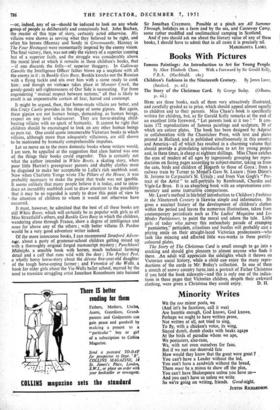Books With Pictures
Famous Paintings: An Introduction to Art for Young People. By Alice Elizabeth Chase. With a Foreword by Sir Gerald Kelly, P. R. A. (Macdoinald. r 8s.)
The Story of the Christmas Card. By George Buday. (Odhams. 3s. 6d.)
HERE are three books, each of them very attractively illustrated, and carefully graded as to price, which should appeal almost equally to children and to their parents. Miss Chase's book is specifically written for children, but, as Sir Gerald Kelly remarks at the end of an excellent little foreword, "Let parents look at it too ! " It con- tains 172 reproductions of famous paintings and sculpture, 50 of which are colour plates. The book has been designed by Adprint in collaboration with the Chanticleer Press, with text and plates printed in Holland, and is published simultaneously in this country and America—all of which has resulted in a charming volume that should provide a Atimulating introduction to art for young people and, in these times, is cheap at eighteen shillings. Miss Chase catches the eyes of readers of all ages by ingeniously grouping her repro- ductions on facing pages according to subject-matter, taking us from the cats, birds and children of Ilogarth to those of Goya ; from a railway train by Turner to Moues Gare St. Lazare ; from Dilrer's St. Jerome to CarpacCio'i St. Ursula ; and from Van Gogh's "Por- trait of the Artist" to self-portraits by Rembrandt, Chardin and Vigde-Le Brun. It is an abmrbing book with an unpretentious com- mentary and some instructive comparisons.
Mr. Layer's method in hiskrief introduction to Children's Fashions in the Nineteenth Century is likewise simple and informative. He gives a succinct history of the development of children's clothes within the period and leaves the numerous illustrations, taken from contemporary periodicals such as The Ladies' Magazine and Les Modes Parisiennes, to point the moral and adorn the tale. Little girls of today who esurvey this melancholy parade of cramping " pantalettes," petticoats, crinolines and bustles will probably cast a pitying smile on their straight-laced Victorian predecessors—who look like mincing and affected little wax-works in these prettily. coloured plates.
The Story of The Christmas Card is small enough to go into a stocking and should give pleasure to almost anyone who finds it there. An adult Will appreciate the sidelights which it throws on Victorian social history, while a child can enjoy the many repro- ductions of the cards in me 130:lay's collection. In one of them a stretch of snowy country turns into,a portrait of Father Christmas if you hold the book sidew0s—and this is only one of the indica- tions in these pages that Victorian children, despite their awkward clothing, were given a Christmas they could enjoy. D. H.


















































 Previous page
Previous page